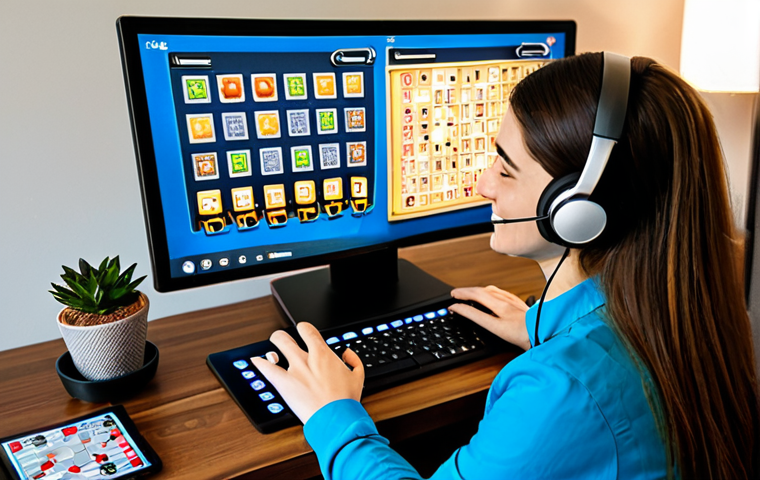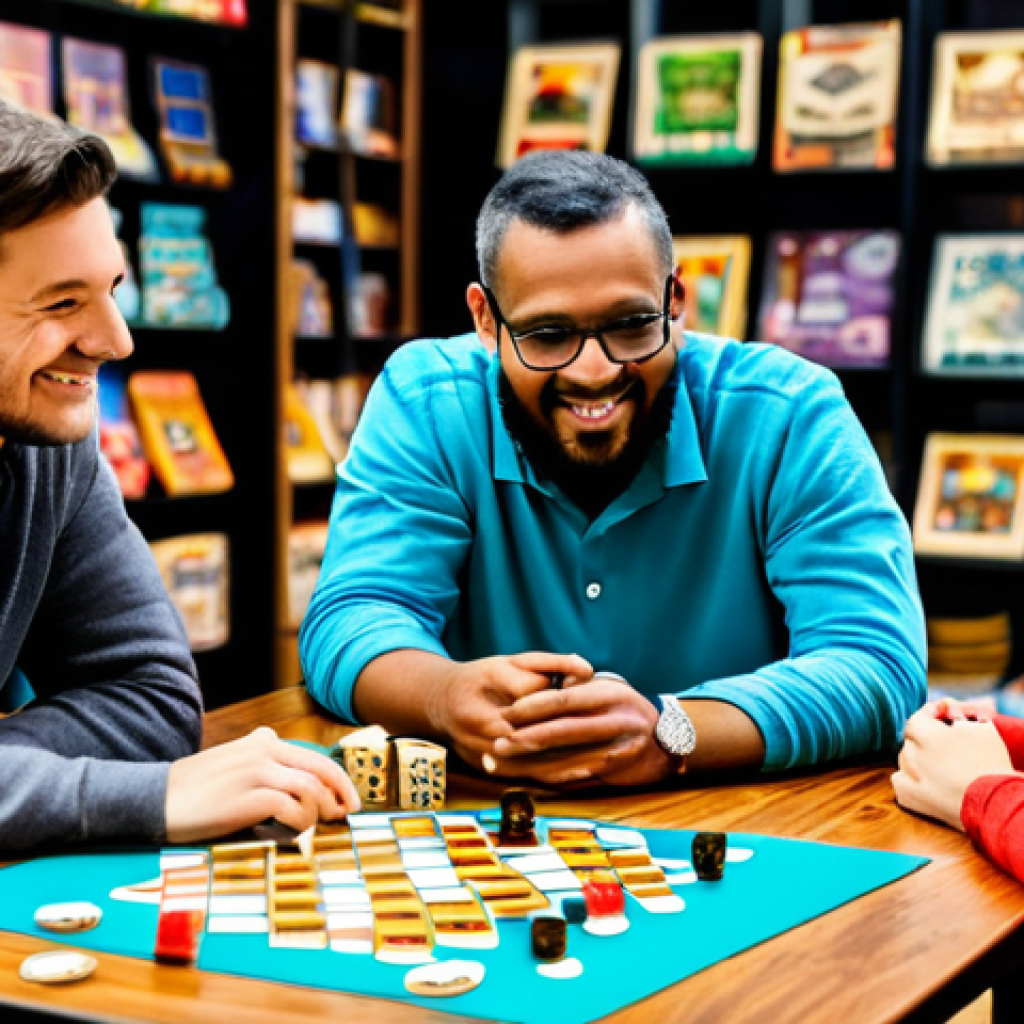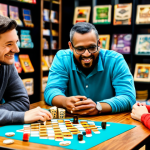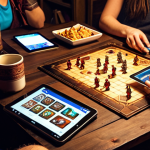There’s an undeniable magic that happens when you gather around a table, dice clattering and cards shuffling, with a shared sense of anticipation hanging in the air.
As someone who’s spent countless evenings immersed in the strategic depths of a new game, I’ve personally felt the incredible joy and unique camaraderie that blossoms when connecting with fellow board game enthusiasts.
It’s truly more than just rolling dice or moving pawns; it’s about forging genuine connections, sharing uproarious laughter, and, yes, a healthy dose of competitive banter that builds lasting memories.
Even as our world leans more digital, the tangible, face-to-face interaction of a dedicated board game night remains a precious commodity, though I’ve also noticed a massive surge in vibrant online communities like those on BoardGameArena, effectively bridging geographical gaps and opening up new avenues for play.
From bustling local meetups to sprawling online guilds debating the latest Kickstarter, the landscape of board game interaction is constantly evolving, raising fascinating questions about community, accessibility, and the very future of our beloved hobby.
Let’s dive deeper into this below.
There’s an undeniable magic that happens when you gather around a table, dice clattering and cards shuffling, with a shared sense of anticipation hanging in the air.
As someone who’s spent countless evenings immersed in the strategic depths of a new game, I’ve personally felt the incredible joy and unique camaraderie that blossoms when connecting with fellow board game enthusiasts.
It’s truly more than just rolling dice or moving pawns; it’s about forging genuine connections, sharing uproarious laughter, and, yes, a healthy dose of competitive banter that builds lasting memories.
Even as our world leans more digital, the tangible, face-to-face interaction of a dedicated board game night remains a precious commodity, though I’ve also noticed a massive surge in vibrant online communities like those on BoardGameArena, effectively bridging geographical gaps and opening up new avenues for play.
From bustling local meetups to sprawling online guilds debating the latest Kickstarter, the landscape of board game interaction is constantly evolving, raising fascinating questions about community, accessibility, and the very future of our beloved hobby.
Let’s dive deeper into this below.
The Evolving Landscape of Board Game Communities

Stepping into the world of board games today feels like walking into a vibrant, bustling metropolis compared to the quiet village it once was. For years, our beloved hobby was seen as a niche pursuit, perhaps something you did with family on a rainy day, or a rare gathering with a few dedicated friends. But oh, how times have changed! I remember hunting for obscure titles in dimly lit game stores, feeling like I was part of a secret society. Now, you see board games everywhere – in trendy cafes, on mainstream television shows, even in dedicated bars. This explosion hasn’t just brought more games; it’s sparked a revolution in how we connect over them. The shift from a select few enthusiasts to a broad, diverse demographic has fundamentally reshaped our communities, making them more accessible, more dynamic, and infinitely more interesting. This isn’t just about bigger conventions or more online forums; it’s about a cultural embrace of tabletop gaming that has pulled countless new players into our orbit, each bringing their own perspectives and preferences.
1. The Rise of Accessibility: From FLGS to Online Platforms
It’s incredible to witness how much easier it is now for someone new to stumble into the hobby. Back when I started, you really had to seek out your local friendly game store (FLGS), hoping they had a game night or a helpful staff member to guide you. That direct, face-to-face interaction at a local store remains incredibly important, a cornerstone of many communities, but it’s no longer the only entry point. The advent of intuitive online platforms, comprehensive review sites, and engaging YouTube channels has made discovering and learning about games a breeze. Someone can now watch a “how-to-play” video for a complex game, join a Discord server dedicated to it, and be playing a digital version with strangers across the globe within hours. This has lowered the barrier to entry significantly, allowing people who might never have found a local group to still dive headfirst into the fun.
2. A New Golden Age: Beyond Monopoly and Scrabble
The stereotype of board games being limited to childhood classics like Monopoly or Scrabble has thankfully been shattered. We are truly living in a “Golden Age” of board game design, with an astonishing variety of genres, mechanics, and themes available. From sprawling cooperative adventures to intense strategic Eurogames, and witty party games, there’s something for absolutely everyone. This diversity has naturally led to the formation of specialized communities. I’ve personally seen groups dedicated solely to legacy games, or abstract strategy, or even just social deduction games. This specialization allows for deeper connections among people who share very specific interests, fostering a sense of belonging that’s genuinely heartwarming. It’s no longer just “board game night”; it’s “our weekly Catan strategy session” or “the Gloomhaven crew’s next campaign.”
From Local Tables to Global Servers: Where We Connect
The beauty of the board gaming community, as I’ve experienced it, lies in its incredible versatility when it comes to connection. There’s something inherently grounding about physically being at a table, hands touching the same cards, eyes meeting over shared laughter or frustrated groans. That tactile experience, the smell of new cardboard, the weight of finely crafted components – it’s irreplaceable. Yet, the past few years have shown us just how resilient and adaptable our hobby is. When physical gatherings weren’t an option, our communities didn’t just evaporate; they shifted, they innovated, they found new digital homes. This dual nature of connection, spanning from the intimate setting of a kitchen table to vast, interconnected online networks, truly showcases the depth and breadth of our shared passion. I’ve personally spent evenings both intensely focused on a game with friends just inches away and simultaneously communicating with players thousands of miles away through a headset, and each experience, while different, offered its own unique flavor of joy and connection.
1. The Enduring Charm of Face-to-Face Gatherings
For many of us, the heart of board gaming still beats strongest at a physical table. Whether it’s a regular game night at a friend’s house, a bustling meetup at a local game store, or the epic scale of conventions like Gen Con or Essen Spiel, these in-person events offer a richness of interaction that digital platforms can’t fully replicate. I cherish the moments of spontaneous conversation, the shared snacks, the subtle nuances of body language that add so much to the strategic play. There’s an immediate camaraderie that forms when you’re physically sharing space and time, the kind that transforms acquaintances into genuine friends. My fondest gaming memories are almost invariably tied to these direct, tangible experiences – the collective sigh after a tough boss fight, the uproarious laughter when someone makes a spectacular blunder, or the focused silence as we puzzle out a complex turn together. These moments build bonds that extend far beyond the game itself.
2. Bridging Distances: The Power of Online Hubs
While I adore physical meetups, I can’t deny the transformative power of online board gaming. Platforms like BoardGameArena (BGA) and Tabletop Simulator (TTS), alongside communication hubs like Discord, have been absolute game-changers. They allow me to play with friends who’ve moved across the country, connect with international players, and even quickly demo games I’m considering buying. The convenience is unparalleled – no setup, no cleanup, and often automated rule enforcement which is a godsend for complex games. Discord servers have become vibrant communities in their own right, offering spaces for strategy discussion, game recommendations, and even organizing impromptu online games. Reddit communities, Facebook groups, and even Twitch streams where people play games live, have cultivated massive, engaged audiences. These digital spaces aren’t just substitutes; they’ve become essential extensions of our physical communities, ensuring that geographical barriers no longer mean an end to shared gaming experiences. It’s a different kind of connection, often more focused on the game itself, but invaluable for keeping the dice rolling.
| Aspect | Physical Meetups (e.g., FLGS, Home Games) | Online Platforms (e.g., BGA, TTS, Discord) |
|---|---|---|
| Atmosphere & Sensory Experience | The tangible feel of components, shared snacks, unique ambient noise, face-to-face interaction and body language. | Visual interface, often requires voice chat for social interaction, highly structured rule enforcement, less “physical” interaction. |
| Accessibility & Convenience | Requires physical presence, travel, scheduling coordination; often limited by local groups and available space. | Play from anywhere, anytime; vast player pool; instant setup and teardown; ideal for busy schedules or remote friends. |
| Social Dynamics | Deep personal connections, reading expressions, spontaneous conversations, shared physical space creating intimacy. | Can be less personal, reliance on digital communication, easier to drop in/out, wider network but potentially shallower connections. |
| Game Availability & Cost | Depends on personal collections or store libraries; physical game purchase costs; potential for rental or demo. | Vast digital libraries, often subscription-based or free-to-play with expansions; no physical storage needed. |
The Intangible Rewards of Shared Gaming Experiences
Beyond the simple act of playing a game, there are profound, often intangible rewards that ripple through our lives when we engage with board game communities. I’ve personally found that these gatherings offer a unique blend of intellectual stimulation and emotional fulfillment that few other hobbies can match. It’s not just about winning or losing; it’s about the journey we take together, the problems we collectively solve, and the sheer delight of shared experiences. In a world that often feels isolating, sitting down at a table, whether physical or virtual, and diving into a rich narrative or a complex strategic puzzle with others, creates a powerful sense of connection. The laughter, the friendly rivalries, the collaborative successes – these are the true treasures of our hobby, fostering a sense of belonging and well-being that truly enhances my life, and I’ve seen it do the same for countless others. It’s a space where you can let your guard down, be a bit silly, or be intensely competitive, all within a supportive framework.
1. Beyond the Game: Forging Genuine Friendships
I can confidently say that some of my strongest friendships have been forged over a board game table. There’s something about navigating a fictional crisis together, or engaging in a bit of good-natured betrayal, that accelerates the bonding process. You see people’s true colors – their patience, their wit, their strategic brilliance, and even their delightful quirks – when the pressure of a game is on. These shared experiences create inside jokes, memorable anecdotes, and a deeper understanding of each other’s personalities. It’s a low-pressure environment for connection, where the game itself provides a natural starting point for conversation and interaction, allowing relationships to blossom organically. I’ve seen introverts open up, strangers become allies, and casual acquaintances evolve into lifelong companions, all because they found common ground and shared joy in rolling dice or laying tiles.
2. Cultivating Skills: Strategy, Patience, and Sportsmanship
While the fun is paramount, I’ve also realized that board games are fantastic incubators for valuable life skills. My own strategic thinking, problem-solving abilities, and even my patience have undoubtedly improved through countless hours of gameplay. Complex Eurogames force you to think several steps ahead, while cooperative games demand effective communication and collaboration. And perhaps most importantly, the gaming table is a fantastic arena for practicing sportsmanship. Learning to lose gracefully, to congratulate your opponent genuinely, and to handle a frustrating turn of events with a smile – these are all critical social skills that are honed through consistent play. It’s a safe space to practice resilience, adapt to changing circumstances, and understand that sometimes, despite your best efforts, the dice just aren’t on your side. These are lessons that extend far beyond the game itself and into everyday life.
Navigating the Digital Frontier: Online Play and Its Nuances
The rise of online board gaming platforms has been nothing short of revolutionary, fundamentally altering how we access and engage with our hobby. From my personal experience, being able to jump into a game of Terraforming Mars with friends across different time zones or quickly learn a new game through an automated tutorial on BoardGameArena has added an incredible layer of convenience and accessibility that was unimaginable just a decade ago. However, this digital frontier, while immensely beneficial, isn’t without its unique nuances and trade-offs. The feel of physical components, the unspoken communication across the table, the immediate, spontaneous laughter – these are elements that digital play struggles to replicate entirely. It’s a different beast, offering distinct advantages and requiring a slightly different approach to maximize enjoyment and maintain that vital human connection. Understanding these subtle differences is key to truly leveraging what online board gaming has to offer without feeling like something important is lost.
1. The Convenience vs. Connection Conundrum
Online board gaming undeniably wins on convenience. No setup, no cleanup, often automated rule enforcement, and the ability to play with anyone, anywhere, anytime. I’ve personally used these platforms to keep game nights alive when life gets busy or when friends move away. Yet, this convenience sometimes comes at the cost of the deeper, more organic social connection you get from face-to-face play. While voice chat helps bridge the gap, it’s not the same as reading someone’s entire body language or sharing a genuine high-five after a clever move. The interactions can feel more transactional, focused purely on the game mechanics rather than the broader social experience. It’s a balance, and I’ve found that the best online experiences are often with people you already have a strong real-world connection with, where the digital platform simply facilitates continued interaction rather than initiating it from scratch.
2. Optimizing Your Virtual Board Game Night
Having navigated countless virtual game nights myself, I’ve learned a few tricks to make them feel as close to the real thing as possible. Firstly, always use voice chat; it’s non-negotiable for real interaction. Seeing faces via video chat, if possible, adds another layer of presence. Secondly, consider “virtual snacks” or drinks – even if you’re just enjoying your own beverage, knowing your friends are doing the same creates a shared atmosphere. Thirdly, don’t just jump straight into the game. Take a few minutes to chat, catch up, and create that social buffer that happens naturally before a physical game starts. I also recommend picking games that translate well digitally, perhaps those with less direct player interaction or component manipulation that gets lost on a screen. For example, a heavy Eurogame might shine online, but a dexterity game or one with lots of hidden information and subtle tells might feel less engaging. Finally, setting clear expectations for rules and turn-taking helps keep the game flowing smoothly, as digital hiccups can be more frustrating than physical ones.
Building Bridges: How Communities Foster Inclusivity
One of the most heartwarming aspects of the board gaming community, from my personal vantage point, is its growing commitment to inclusivity. What was once perceived as a hobby dominated by a very specific demographic is steadily transforming into a vibrant tapestry of people from all walks of life. I’ve seen firsthand how a welcoming local game store can become a safe haven for diverse groups, and how online forums actively work to create environments where everyone feels comfortable to share their passion. This isn’t just about being “nice”; it’s about intentionally designing spaces and fostering attitudes that break down barriers, whether they be based on age, gender, race, experience level, or ability. It’s a continuous journey, but the progress I’ve witnessed gives me immense hope for the future of our hobby. When everyone feels welcome at the table, the collective experience becomes infinitely richer and more enjoyable for absolutely everyone involved.
1. Welcoming Newcomers: Reducing the Barrier to Entry
The sheer volume of new games and complex rules can be incredibly daunting for someone just stepping into the hobby. I remember feeling overwhelmed myself, trying to decipher rulebooks that felt like ancient scrolls. True inclusivity starts with actively welcoming newcomers and reducing that initial barrier to entry. This means patient teachers at game nights, clear and concise beginner guides online, and communities that celebrate learning rather than gatekeeping. Many local groups offer “learn-to-play” sessions, or designate certain nights for lighter, more accessible games. Online, forums are filled with helpful individuals eager to answer questions, and content creators produce fantastic tutorials. It’s about creating an atmosphere where asking “how do I play this?” is met with enthusiasm, not judgment, and where the focus is on fun and shared discovery, not just mastery. I’ve found that the most thriving communities are those that actively nurture their newest members.
2. Diversity and Representation at the Table
For board gaming to truly be for everyone, it needs to reflect the diversity of the world we live in. This means not only ensuring that diverse players feel welcome but also actively promoting representation within the games themselves and among content creators. I’ve been thrilled to see a growing movement towards more inclusive art, themes, and character options in new game designs. Beyond the games, many communities are making conscious efforts to highlight diverse voices, whether they are streamers, designers, or simply players sharing their experiences. This intentional push for diversity enriches the hobby for everyone. When people see themselves represented, and when voices from different backgrounds contribute to the conversation, the hobby becomes more vibrant, more innovative, and ultimately, more universally appealing. It’s about recognizing that different perspectives lead to richer discussions and more enjoyable gameplay for all.
The Economic Backbone: Supporting the Hobby and Its Creators
The vibrant board game communities we cherish don’t exist in a vacuum; they are intrinsically linked to a thriving ecosystem of designers, publishers, artists, retailers, and content creators. From my perspective as an avid player, supporting this economic backbone is not just a nice thing to do; it’s essential for the continued growth and innovation of our hobby. Every purchase, every crowdfunding pledge, every Patreon subscription contributes directly to the ability of creators to bring new and exciting experiences to our tables. It’s a symbiotic relationship: we, the players, provide the demand and the financial fuel, and in return, we receive an ever-expanding universe of incredible games. I’ve personally seen how a successful Kickstarter campaign can launch a designer’s career, or how a struggling local game store can be revitalized by community support. This isn’t just about consumerism; it’s about investing in a passion that brings so much joy and connection to so many people worldwide.
1. Fueling Innovation: The Role of Enthusiasts in Crowdfunding
Crowdfunding platforms like Kickstarter and Gamefound have become absolute powerhouses for board game innovation. As someone who’s backed more than a few projects, I feel a direct sense of contribution to the hobby’s evolution. These platforms allow designers to bypass traditional publishing gatekeepers and bring incredibly ambitious or niche projects directly to the players who want them. It’s a leap of faith for both sides – designers trust us to fund their dreams, and we trust them to deliver. This model has led to some of the most groundbreaking and beloved games of the last decade, games that might never have seen the light of day otherwise. The community’s willingness to support these ventures upfront directly fuels the creativity and risk-taking necessary for the hobby to constantly push its boundaries, resulting in an endless stream of fresh, exciting experiences for us all to enjoy.
2. The Local Game Store: More Than Just a Shop
While online shopping offers convenience, I truly believe that the local game store (FLGS) is the heart and soul of many board game communities. My FLGS isn’t just a place where I buy games; it’s where I discover new titles, meet fellow enthusiasts, attend game nights, and get expert advice. They often host tournaments, provide demo copies, and serve as vital community hubs. During challenging times, I’ve seen these stores rally their communities, offering curbside pickup or online events to stay afloat. Supporting them through purchases, attending their events, or simply spreading the word is crucial. They are often run by passionate individuals who pour their lives into fostering a local gaming scene. Without these physical spaces, a huge part of the face-to-face community infrastructure would crumble, and we’d lose invaluable touchpoints for discovering the hobby and connecting with others in person.
Looking Ahead: The Future of Board Game Interaction
Peering into the future of board game interaction feels both exciting and a little bit uncertain, which, for someone who loves the dynamic nature of this hobby, is actually a thrill. The rapid technological advancements we’re seeing, coupled with the continued growth in popularity, suggest a landscape that will be even more diverse and interconnected. I envision a world where the lines between physical and digital play become increasingly blurred, where innovative technologies enhance our tabletop experiences rather than replacing them. We’ve seen glimmers of this already with companion apps for board games or hybrid games that blend physical components with digital elements. The core appeal of tactile play and face-to-face interaction will always remain, I believe, but the ways we discover, learn, and play games together are ripe for evolution. It’s a thrilling prospect, imagining how our communities will continue to adapt and expand, inviting even more people to the table, whatever that “table” might look like in the years to come. The innovation is constant, and that’s precisely what keeps me so deeply engaged.
1. Embracing New Technologies: VR and Beyond
While the tangible feel of cardboard and wood will always hold a special place in my heart, I can’t help but feel excited about the potential for technologies like Virtual Reality (VR) and Augmented Reality (AR) to enhance our board gaming experiences. Imagine stepping into a fully immersive digital representation of a game board, manipulating pieces with your own virtual hands, and seeing your friends’ avatars around the table, regardless of where they are physically located. We’re already seeing impressive developments with VR implementations of games like Catan or Demeo. AR could overlay digital elements onto a physical table, adding animated characters, dynamic scores, or guided tutorials. These technologies could make complex games more approachable, facilitate remote play with a greater sense of presence, and open up entirely new design possibilities for game creators. It won’t replace traditional play, but it will certainly offer a compelling alternative that could onboard a new generation of players.
2. The Enduring Allure of Tangible Play
Despite all the exciting technological advancements, I am absolutely convinced that the fundamental allure of tangible, physical board games will endure. There’s an undeniable, primal satisfaction that comes from holding cards in your hand, rolling actual dice, and moving physical pieces across a beautifully illustrated board. This sensory experience is a huge part of the appeal for many of us, myself included. It’s a break from screen time, a chance to disconnect from the digital world and truly engage with people in a shared physical space. The unscripted moments – the shared laughter, the spontaneous banter, the ability to read a friend’s tell by their shifting eyes – are impossible to fully replicate digitally. As technology progresses, I believe the value of these genuine, offline connections will only increase, cementing the place of physical board games as a cherished and timeless social activity. Our communities will likely become hybrid, embracing both the best of digital convenience and the irreplaceable charm of the real-world tabletop.
Wrapping Up
As we’ve explored, the world of board game communities is a dynamic, ever-evolving tapestry of connection. From the cherished clatter of dice at a physical table to the seamless interactions on global digital platforms, our shared passion for tabletop games continues to foster incredible bonds. It’s a journey of discovery, strategy, laughter, and genuine camaraderie, proving that no matter how we play, the human connection remains at the heart of our beloved hobby. This vibrant landscape, rich with diverse experiences and opportunities for growth, is a testament to the enduring magic of board games.
Useful Information to Know
1. Find Your Local Hub: Start by searching for your Friendly Local Game Store (FLGS). Many host regular game nights, offer demo copies, and are fantastic places to meet like-minded players in person. Websites like Meetup.com are also great for finding local gaming groups.
2. Dive into Digital: Explore online platforms like BoardGameArena.com (BGA) for asynchronous or real-time play, or Tabletop Simulator (TTS) on Steam for a more sandbox-style virtual experience. Discord is invaluable for voice chat and community discussion.
3. Don’t Be Afraid to Ask: The board game community is generally very welcoming to newcomers. If you’re unsure about rules or game recommendations, don’t hesitate to ask questions at game nights, on Reddit (e.g., r/boardgames), or in dedicated Discord servers.
4. Attend a Convention: If you have the opportunity, attending a board game convention (like Gen Con in the US, Essen Spiel in Germany, or PAX Unplugged) is an unparalleled experience to see new releases, meet designers, and play hundreds of games.
5. Support the Creators and Retailers: Whether it’s backing a Kickstarter project, buying games from your FLGS, or supporting content creators on platforms like Patreon, your support helps ensure the hobby continues to thrive and innovate.
Key Takeaways
The board game community thrives on its adaptability, seamlessly blending cherished face-to-face gatherings with the expansive reach of online platforms. This evolution has made the hobby more accessible and diverse, fostering genuine friendships, cultivating valuable life skills like strategy and sportsmanship, and providing a powerful sense of belonging. By actively embracing inclusivity and supporting the ecosystem of creators and retailers, we ensure a vibrant, innovative future for tabletop gaming, one where connection and shared joy remain paramount.
Frequently Asked Questions (FAQ) 📖
Q: The intro mentions an “undeniable magic” and that it’s “more than just rolling dice.” What specifically makes board gaming such a uniquely captivating and memorable experience?
A: Oh, that’s the heart of it, isn’t it? From my own years spent around a game table, the magic isn’t just in the rules or the win; it’s the raw, unscripted moments.
I’ve had nights where the strategic tension was so thick you could cut it with a knife, only for it to explode into uproarious laughter over a ridiculous dice roll or a brilliantly executed (or spectacularly failed) plan.
It’s the shared problem-solving, the collective groan when someone draws the worst card, the high-fives after a clever combo. These aren’t just mechanics; they’re catalysts for genuine human connection, where you actually feel yourself bonding with the people across from you.
That tangible interaction, the eye contact, the shared snacks – that’s what sticks with you long after the game is packed away. It builds a history with your friends, full of inside jokes and epic tales.
Q: You touched on the contrast between physical, face-to-face board game nights and the “massive surge” in online communities. How do these two experiences compare, and are online platforms truly a suitable substitute for the traditional tabletop gathering?
A: That’s a fantastic question, and one I grapple with myself. Honestly, nothing fully replaces the tactile joy of shuffling real cards, clattering actual dice, or seeing the genuine reactions on your friends’ faces right there in the room.
There’s an irreplaceable energy to a physical game night. However, calling online platforms like BoardGameArena a “substitute” might miss the point. From my perspective, they’re more like an incredible expansion.
I’ve used them extensively to keep playing with friends who’ve moved cross-country, or to try out new games quickly without the setup hassle. While you lose some of that physical presence, you gain incredible accessibility – I mean, how else could I play a complex Eurogame with a friend in London at 10 PM on a Tuesday?
They bridge geographical gaps effortlessly and introduce you to a global community you’d never meet otherwise. So, no, not a perfect replica, but an indispensable tool that keeps the hobby vibrant and connected.
Q: With the “constantly evolving” landscape, what do you foresee as the biggest trends or transformations in how board game enthusiasts will connect and interact in the future?
A: Oh, the future of this hobby is always buzzing in my mind! I truly believe we’re headed towards a fascinating hybrid model, where the lines between physical and digital will blur even further.
I can totally imagine more games integrating app components that aren’t just digital rulebooks, but active participants, perhaps handling complex calculations or even acting as a “GM” for solo play.
Kickstarter and crowdfunding will only continue to be central, fostering even more direct creator-player communities. What excites me most is the potential for even greater accessibility – not just geographically via online platforms, but also for people with different needs, perhaps through more thoughtfully designed components or digital aids.
The core, though, the reason we gather, won’t change: it’s about sharing an experience. Whether that’s around a table piled high with cardboard or coordinating turns across continents, the drive for connection and shared narrative is what will keep this incredible hobby thriving and evolving.
📚 References
Wikipedia Encyclopedia
구글 검색 결과
구글 검색 결과
구글 검색 결과
구글 검색 결과
구글 검색 결과





